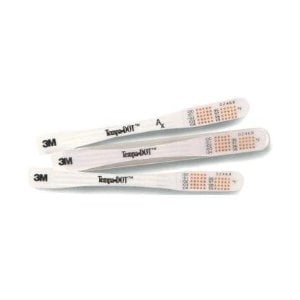
Problem being addressed[edit | edit source]
Infection is a large contributor to maternal mortality and morbidity in developing countries. Nearly one third of all maternal deaths are attributed to infection, which could easily be prevented by minimal improvements in care that would allow for earlier detection of infection, such as proper detection of fevers. Standard glass and mercury thermometers are not suitable for resource limited environments since they can be easily broken and not readily transportable. Many digital thermometer models are often very expensive and require battery replacement so there needs to be another alternative. Additionally, there is the issue of sanitizing thermometers or using sleeves so that they can be re-used.
Detailed description of the solution[edit | edit source]
Tempa•DOT thermometers are accurate, convenient, versatile and economical body temperature measuring devices. Clinically accurate oral body temperature can be obtained in 60 seconds and axillary temperatures in three minutes. Tempa•DOT thermometers use a dot sensor matrix consisting of temperature-sensitive indicating dots. Each dot changes color from tan to blue at a specific temperature relative to the melting point of the specific chemical mixture of the dot. Each dot changes color at a temperature of 0.2°F or 0.1°C higher than the preceding dot. Body temperature is read from a numerical temperature scale.
Designed by[edit | edit source]
- Designed by: 3M
References[edit | edit source]
Peer-reviewed publication[edit | edit source]
Macqueen, S. (2011). Clinical Benefits of 3M Tempa.DOT Thermometer in Paediatric Settings." British Journal of Nursing, 10(1), 55-58.
Other internally generated reports[edit | edit source]
3M Global Gateway Page. (2011). Tempa•DOT™. Retrieved 13 November, 2011 from http://web.archive.org/web/20171225025639/http://solutions.3msverige.se:80/wps/portal/3M/sv_SE/EU-HealthCare/Home/ProdInfo/MedicalSupplies/Tempadot.
Externally generated reports[edit | edit source]
BBC News. (Febr. 28 2006). "Birthing Suit 'could save Lives'" Retrieved November 13, 2011 from http://news.bbc.co.uk/2/hi/health/4757978.stm.
IP and copyright[edit | edit source]
Covered by U.S. Patent No.’s 4189942, 4232552, 4345470,4397570, 4339207, 4362645, and foreign counterparts.